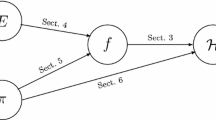Abstract
This paper reveals a duality between constructions of two basic cryptographic primitives, pseudo-random string generators and one-way hash functions. Applying the duality, we present a construction for universal one-way hash functions assuming the existence of one-way permutations. Under a stronger assumption, the existence of distinction-intractable permutations, we prove that the construction constitutes a collision-intractable hash function. Using ideas behind the construction, we propose practical one-way hash functions, the fastest of which compress nearly 2n-bit long input into n-bit long output strings by applying only twice a one-way function.
Preview
Unable to display preview. Download preview PDF.
Similar content being viewed by others
References
M. Blum and S. Micali, How to generate cryptographically strong sequences of pseudo-random bits, SIAM J. on Comp. 13 (1984) 850–864.
R. Boppana and R. Hirschfeld, Pseudorandom generations and complexity classes, in: S. Micali, ed., Randomness and Computation, (JAI Press Inc., 1989) 1–26.
I. Damgård, A design principle for hash functions, Presented at Crypto'89 (1989).
O. Goldreich, S. Goldwasser and S. Micali, How to construct random functions, J. of ACM 33 (1986) 792–807.
S. Goldwasser and S. Micali, Probabilistic encryption, J. of Comp. and Sys. Sci. 28 (1984) 270–299.
R. Impagliazzo, L. Levin and M. Luby, Pseudo-random generation from one-way functions, Proc. of the 21-th ACM STOC (1989) 12–24.
R. Impagliazzo and M. Luby, One-way functions are essential for complexity based cryptography, Proc. of the 30-th IEEE FOCS (1989) 230–235.
R. Merkle, One way hash functions and DES, Presented at Crypto'89 (1989).
S. Micali and C.P. Schnorr, Super-efficient, perfect random number generators, in: S. Goldwasser, ed., Proc. of Crypto'88, (Springer-Verlag, 1990) 173–198.
M. Naor and M. Yung, Universal one-way hash functions and their cryptographic applications, Proc. of the 21-th ACM STOC (1989) 33–43.
K. Nishimura and M. Sibuya, Probability to meet in the middle, J. of Cryptology 2 (1990) 13–22.
M. Wegman and J. Carter, New hash functions and their use in authentication and set equality, J. of Comp. and Sys. Sci. 22 (1981) 265–279.
A. Yao, Theory and applications of trapdoor functions, Proc. of the 23-th IEEE FOCS (1982) 80–91.
Y. Zheng, T. Matsumoto and H. Imai, On the construction of block ciphers provably secure and not relying on any unproved hypotheses, Presented at Crypto'89, (1989).
Y. Zheng, T. Matsumoto and H. Imai, Connections among several versions of one-way hash functions, Proc. of IEICE of Japan E73 (July 1990).
Y. Zheng, T. Matsumoto and H. Imai, Structural properties of one-way hash functions, Presented at Crypto'90, (1990).
Author information
Authors and Affiliations
Editor information
Rights and permissions
Copyright information
© 1991 Springer-Verlag Berlin Heidelberg
About this paper
Cite this paper
Zheng, Y., Matsumoto, T., Imai, H. (1991). Duality between two cryptographic primitives. In: Sakata, S. (eds) Applied Algebra, Algebraic Algorithms and Error-Correcting Codes. AAECC 1990. Lecture Notes in Computer Science, vol 508. Springer, Berlin, Heidelberg. https://doi.org/10.1007/3-540-54195-0_66
Download citation
DOI: https://doi.org/10.1007/3-540-54195-0_66
Published:
Publisher Name: Springer, Berlin, Heidelberg
Print ISBN: 978-3-540-54195-0
Online ISBN: 978-3-540-47489-0
eBook Packages: Springer Book Archive




